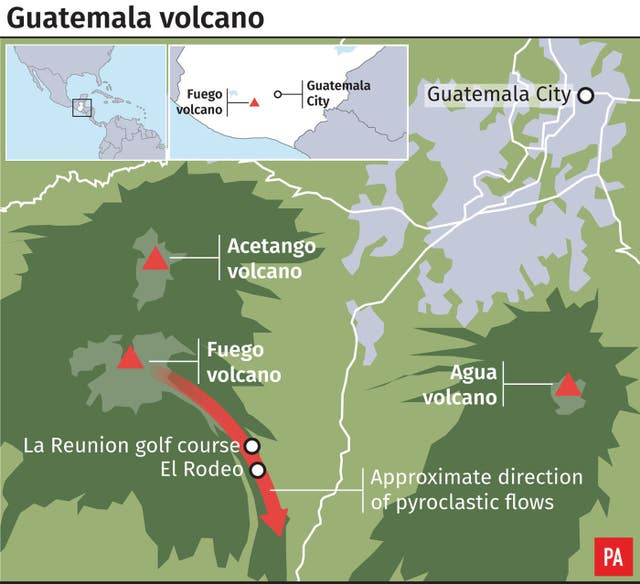
Emergency crews pulled more bodies from what remained of villages devastated by the eruption of Guatemala’s Volcano of Fire on Wednesday, but time was quickly running out to find survivors as the confirmed death toll rose to 99.
Nearly 200 people were still missing, but firefighters said the chance of finding anyone alive amid the still-steaming terrain was practically non-existent 72 hours after Sunday’s volcanic explosion.
Thousands of people displaced by the eruption have sought refuge in shelters, many of them of with dead or missing loved ones and facing an uncertain future, unable to return to homes destroyed by the volcano.
Thick grey ash covering the stricken region was hardened by rainfall, making it even more difficult to dig through the mud, rocks and debris that reached to the rooftops of homes.
 Efrain Suarez walks through a barren terrain (AP Photo/Moises Castillo)
Efrain Suarez walks through a barren terrain (AP Photo/Moises Castillo)
“Nobody is going to be able to get them out or say how many are buried here,” Efrain Suarez said, standing amid the smoking holes dotting what used to be the village of San Miguel Los Lotes on the flanks of the mountain.
“The bodies are already charred,” the 59-year-old truck driver said. “And if heavy machinery comes in they will be torn apart.”
Once a verdant collection of canyons, hillsides and farms, the land is now a barren moonscape. Rescuers poked metal rods into the ground, sending clouds of smoke pouring into the air in a sign of the super-hot temperatures still remaining below the surface, which firefighters said reached as high as 750 to 1,300 degrees Fahrenheit (400 to 700 degrees Celsius) in some places.
There were glimmers of a return to some semblance of normality as Guatemalans across the country donated supplies and local volunteers reached out to those in need.
 The location of the Guatemala volcano (PA Graphics)
The location of the Guatemala volcano (PA Graphics)
A day after a new evacuation was ordered due to increasing activity by the volcano, a red alert remained in place for the departments of Escuintla, Sacatepequez and Chimaltenango, and people were advised not to linger near the affected zones.
The country’s seismology and volcanology institute warned of new flows descending on Wednesday afternoon through canyons on the volcano’s western slope toward the Pantaleon River, carrying boulders and tree trunks.
Authorities also warned that rain had increased the chance of deadly slides of ash, mud and debris.
The recovery effort was slow, with local media reports saying nine bodies were recovered on Wednesday.
A man whose rescue in the town of El Rodeo was shown on video as he was pulled out caked in mud with third-degree burns over 50% of his body died at a hospital on Wednesday, the country’s Social Security Institute said.
 Guatemalan President Jimmy Morales greets rescue workers (AP Photo/Moises Castillo)
Guatemalan President Jimmy Morales greets rescue workers (AP Photo/Moises Castillo)
The official death toll, which was increased to 99 on Wednesday, was expected to rise more, with at least 197 people listed as missing. About 3,500 were in shelters, many with their homes and livelihoods destroyed.
President Jimmy Morales traveled to El Rodeo by helicopter on Wednesday to survey the destruction.
Authorities suspended search and recovery efforts in the afternoon, citing the dangers posed by rain and new flows of volcanic material and debris.
In past disasters in which authorities determined there was no chance of finding survivors and further efforts to recover bodies would be too difficult, areas have been declared burial sites, the final resting place of the victims.
Asked about that possibility, the director of Guatemala’s disaster agency, Sergio Cabanas, said: “Not until the search efforts are over, and it would be left up to the people.”


Why are you making commenting on The Herald only available to subscribers?
It should have been a safe space for informed debate, somewhere for readers to discuss issues around the biggest stories of the day, but all too often the below the line comments on most websites have become bogged down by off-topic discussions and abuse.
heraldscotland.com is tackling this problem by allowing only subscribers to comment.
We are doing this to improve the experience for our loyal readers and we believe it will reduce the ability of trolls and troublemakers, who occasionally find their way onto our site, to abuse our journalists and readers. We also hope it will help the comments section fulfil its promise as a part of Scotland's conversation with itself.
We are lucky at The Herald. We are read by an informed, educated readership who can add their knowledge and insights to our stories.
That is invaluable.
We are making the subscriber-only change to support our valued readers, who tell us they don't want the site cluttered up with irrelevant comments, untruths and abuse.
In the past, the journalist’s job was to collect and distribute information to the audience. Technology means that readers can shape a discussion. We look forward to hearing from you on heraldscotland.com
Comments & Moderation
Readers’ comments: You are personally liable for the content of any comments you upload to this website, so please act responsibly. We do not pre-moderate or monitor readers’ comments appearing on our websites, but we do post-moderate in response to complaints we receive or otherwise when a potential problem comes to our attention. You can make a complaint by using the ‘report this post’ link . We may then apply our discretion under the user terms to amend or delete comments.
Post moderation is undertaken full-time 9am-6pm on weekdays, and on a part-time basis outwith those hours.
Read the rules here